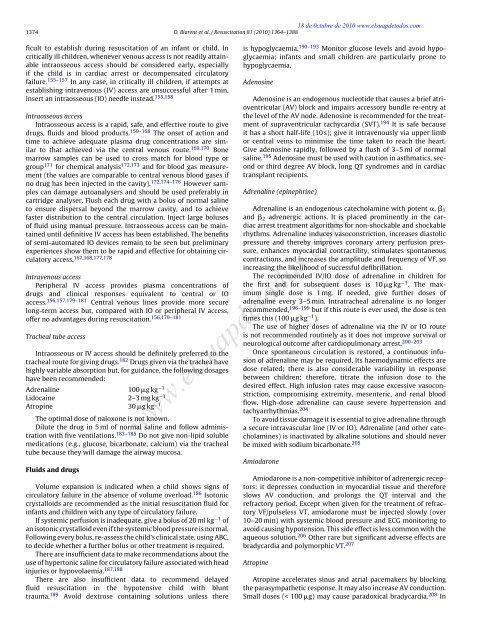European Resuscitation Council Guidelines for Resuscitation ... - CPR
European Resuscitation Council Guidelines for Resuscitation ... - CPR
European Resuscitation Council Guidelines for Resuscitation ... - CPR
You also want an ePaper? Increase the reach of your titles
YUMPU automatically turns print PDFs into web optimized ePapers that Google loves.
18 de 0ctubre de 2010 www.elsuapdetodos.com1374 D. Biarent et al. / <strong>Resuscitation</strong> 81 (2010) 1364–1388ficult to establish during resuscitation of an infant or child. Incritically ill children, whenever venous access is not readily attainableintraosseous access should be considered early, especiallyif the child is in cardiac arrest or decompensated circulatoryfailure. 155–157 In any case, in critically ill children, if attempts atestablishing intravenous (IV) access are unsuccessful after 1 min,insert an intraosseous (IO) needle instead. 155,158Intraosseous accessIntraosseous access is a rapid, safe, and effective route to givedrugs, fluids and blood products. 159–168 The onset of action andtime to achieve adequate plasma drug concentrations are similarto that achieved via the central venous route. 169,170 Bonemarrow samples can be used to cross match <strong>for</strong> blood type orgroup 171 <strong>for</strong> chemical analysis 172,173 and <strong>for</strong> blood gas measurement(the values are comparable to central venous blood gases ifno drug has been injected in the cavity). 172,174–176 However samplescan damage autoanalysers and should be used preferably incartridge analyser. Flush each drug with a bolus of normal salineto ensure dispersal beyond the marrow cavity, and to achievefaster distribution to the central circulation. Inject large bolusesof fluid using manual pressure. Intraosseous access can be maintaineduntil definitive IV access has been established. The benefitsof semi-automated IO devices remain to be seen but preliminaryexperiences show them to be rapid and effective <strong>for</strong> obtaining circulatoryaccess. 167,168,177,178Intravenous accessPeripheral IV access provides plasma concentrations ofdrugs and clinical responses equivalent to central or IOaccess. 156,157,179–181 Central venous lines provide more securelong-term access but, compared with IO or peripheral IV access,offer no advantages during resuscitation. 156,179–181Tracheal tube accessIntraosseous or IV access should be definitely preferred to thetracheal route <strong>for</strong> giving drugs. 182 Drugs given via the trachea havehighly variable absorption but, <strong>for</strong> guidance, the following dosageshave been recommended:Adrenaline100 gkg −1Lidocaine2–3 mg kg −1Atropine30 gkg −1The optimal dose of naloxone is not known.Dilute the drug in 5 ml of normal saline and follow administrationwith five ventilations. 183–185 Do not give non-lipid solublemedications (e.g., glucose, bicarbonate, calcium) via the trachealtube because they will damage the airway mucosa.Fluids and drugsVolume expansion is indicated when a child shows signs ofcirculatory failure in the absence of volume overload. 186 Isotoniccrystalloids are recommended as the initial resuscitation fluid <strong>for</strong>infants and children with any type of circulatory failure.If systemic perfusion is inadequate, give a bolus of 20 ml kg −1 ofan isotonic crystalloid even if the systemic blood pressure is normal.Following every bolus, re-assess the child’s clinical state, using ABC,to decide whether a further bolus or other treatment is required.There are insufficient data to make recommendations about theuse of hypertonic saline <strong>for</strong> circulatory failure associated with headinjuries or hypovolaemia. 187,188There are also insufficient data to recommend delayedfluid resuscitation in the hypotensive child with blunttrauma. 189 Avoid dextrose containing solutions unless thereis hypoglycaemia. 190–193 Monitor glucose levels and avoid hypoglycaemia;infants and small children are particularly prone tohypoglycaemia.AdenosineAdenosine is an endogenous nucleotide that causes a brief atrioventricular(AV) block and impairs accessory bundle re-entry atthe level of the AV node. Adenosine is recommended <strong>for</strong> the treatmentof supraventricular tachycardia (SVT). 194 It is safe becauseit has a short half-life (10 s); give it intravenously via upper limbor central veins to minimise the time taken to reach the heart.Give adenosine rapidly, followed by a flush of 3–5 ml of normalsaline. 195 Adenosine must be used with caution in asthmatics, secondor third degree AV block, long QT syndromes and in cardiactransplant recipients.Adrenaline (epinephrine)Adrenaline is an endogenous catecholamine with potent , 1and 2 adrenergic actions. It is placed prominently in the cardiacarrest treatment algorithms <strong>for</strong> non-shockable and shockablerhythms. Adrenaline induces vasoconstriction, increases diastolicpressure and thereby improves coronary artery perfusion pressure,enhances myocardial contractility, stimulates spontaneouscontractions, and increases the amplitude and frequency of VF, soincreasing the likelihood of successful defibrillation.The recommended IV/IO dose of adrenaline in children <strong>for</strong>the first and <strong>for</strong> subsequent doses is 10 gkg −1 . The maximumsingle dose is 1 mg. If needed, give further doses ofadrenaline every 3–5 min. Intratracheal adrenaline is no longerrecommended, 196–199 but if this route is ever used, the dose is tentimes this (100 gkg −1 ).The use of higher doses of adrenaline via the IV or IO routeis not recommended routinely as it does not improve survival orneurological outcome after cardiopulmonary arrest. 200–203Once spontaneous circulation is restored, a continuous infusionof adrenaline may be required. Its haemodynamic effects aredose related; there is also considerable variability in responsebetween children; there<strong>for</strong>e, titrate the infusion dose to thedesired effect. High infusion rates may cause excessive vasoconstriction,compromising extremity, mesenteric, and renal bloodflow. High-dose adrenaline can cause severe hypertension andtachyarrhythmias. 204To avoid tissue damage it is essential to give adrenaline througha secure intravascular line (IV or IO). Adrenaline (and other catecholamines)is inactivated by alkaline solutions and should neverbe mixed with sodium bicarbonate. 205www.elsuapdetodos.comAmiodaroneAmiodarone is a non-competitive inhibitor of adrenergic receptors:it depresses conduction in myocardial tissue and there<strong>for</strong>eslows AV conduction, and prolongs the QT interval and therefractory period. Except when given <strong>for</strong> the treatment of refractoryVF/pulseless VT, amiodarone must be injected slowly (over10–20 min) with systemic blood pressure and ECG monitoring toavoid causing hypotension. This side effect is less common with theaqueous solution. 206 Other rare but significant adverse effects arebradycardia and polymorphic VT. 207AtropineAtropine accelerates sinus and atrial pacemakers by blockingthe parasympathetic response. It may also increase AV conduction.Small doses (< 100 g) may cause paradoxical bradycardia. 208 In
















